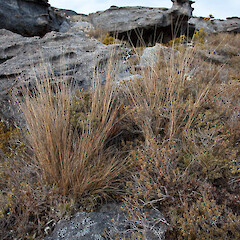Chionochloa juncea
Common name
North Westland snow tussock
Synonyms
Danthonia raoulii var. teretifolia Petrie; Danthonia rigida var. teretifolia (Petrie) Zotov
Family
Poaceae
Flora category
Vascular – Native
Endemic taxon
Yes
Endemic genus
No
Endemic family
No
Structural class
Grasses
NVS code
The National Vegetation Survey (NVS) Databank is a physical archive and electronic databank containing records of over 94,000 vegetation survey plots - including data from over 19,000 permanent plots. NVS maintains a standard set of species code abbreviations that correspond to standard scientific plant names from the Ngä Tipu o Aotearoa - New Zealand Plants database.
CHIJUN
Chromosome number
2n = 42
Current conservation status
The conservation status of all known New Zealand vascular plant taxa at the rank of species and below were reassessed in 2017 using the New Zealand Threat Classification System (NZTCS) – more information about this can be found on the NZTCS website. This report includes a statistical summary and brief notes on changes since 2012 and replaces all previous NZTCS lists for vascular plants.
Please note, threat classifications are often suggested by authors when publications fall between NZTCS assessment periods – an interim threat classification status has not been assessed by the NZTCS panel.
- Conservation status of New Zealand indigenous vascular plants, 2017 . 2018. Peter J. de Lange, Jeremy R. Rolfe, John W. Barkla, Shannel P. Courtney, Paul D. Champion, Leon R. Perrie, Sarah M. Beadel, Kerry A. Ford, Ilse Breitwieser, Ines Schönberger, Rowan Hindmarsh-Walls, Peter B. Heenan and Kate Ladley. Department of Conservation. Source: NZTCS and licensed by DOC for reuse under the Creative Commons Attribution 4.0 International licence.
2017 | At Risk – Declining | Qualifiers: RR
Previous conservation statuses
2012 | At Risk – Declining | Qualifiers: RR
2009 | At Risk – Declining | Qualifiers: RR
2004 | Range Restricted
Distribution
Endemic. New Zealand: North Westland (Denniston and Stockton Plateaus).
Habitat
Montane to subalpine. Locally common in scrub, tussock grassland and swampy ground overlying coal measures.
Wetland plant indicator status rating
Information derived from the revised national wetland plant list prepared to assist councils in delineating and monitoring wetlands (Clarkson et al., 2021 Manaaki Whenua – Landcare Research Contract Report LC3975 for Hawke’s Bay Regional Council). The national plant list categorises plants by the extent to which they are found in wetlands and not ‘drylands’. The indicator status ratings are OBL (obligate wetland), FACW (facultative wetland), FAC (facultative), FACU (facultative upland), and UPL (obligate upland). If you have suggestions for the Wetland Indicator Status Rating, please contact: [Enable JavaScript to view protected content]
FAC: Facultative
Commonly occurs as either a hydrophyte or non-hydrophyte (non-wetlands).
Detailed description
Tall, rush-like, red tussock with swollen bases from rootstock clothed in old leaf-sheaths, leaves persistent, ultimately falling below sheath with one fracture. Leaf-sheath to 150 mm, dark brown, entire, persistent, internerves hairy but often appearing glabrous, margin long hairy above, apical tuft of hairs to 4 mm. Ligule to 0.5 mm. Leaf-blade to 700 × 1 mm, acicular rush-like, finally falling with top part of sheath, abaxially glabrous sometimes with long hairs below aside prominent, shining, hollow keel, becoming glabrous, adaxially with weft of long hairs at base, prickle-teeth above; margin with long hairs below glabrous above. Culm to 900 mm, internodes glabrous. Inflorescence to 200 mm, open, spikelets on long, pulvinate, flexuous branches; rachis and branches sparsely short hairy below becoming glabrous except for few hairs at axils and below spikelets. Spikelets of up to 6 purpled florets. Glumes glabrous, < adjacent lemma lobes; lower to 11 mm, 3-nerved, upper to 12 mm, 5-nerved. Lemma to 5.5 mm; hairs dense on margin, very few aside central nerve, glabrous elsewhere, < sinus; lateral lobes up to 4 mm, including awn up to 2.5 mm; central awn up to 10 mm, reflexed from 1 mm flat column. Palea to 6 mm. Callus to 1 mm, hairs to 3 mm. Rachilla to 0.8 mm. Lodicules to 0.5 mm. Anthers to 3.5 mm. Ovary to 0.5 mm; stigma-styles to 2 mm. Seeds to 2 mm.
Manaaki Whenua Online Interactive Key
Flowering
October–December
Fruiting
November–April
Life cycle
Florets are wind dispersed (Thorsen et al., 2009).
Propagation technique
Easily grown in an acidic, damp soil in full sun or partial shade. Plants dislike drying out and will not tolerate drought or long periods of humidity. Very slow growing. An unusual tussock whose rush-like foliage is very attractive.
Threats
Widespread within the coal measures of North Westland. In most places it is secure, however, open cast coal mining now threatens some large populations.
Etymology
chionochloa: Snow grass
juncea: Rush-like
Attribution
Description modified from Edgar and Connor (2000).
References and further reading
Edgar E, Connor HE. 2000. Flora of New Zealand. Vol. V. Grasses. Christchurch, Manaaki Whenua Press. 650 p.
Thorsen MJ, Dickinson KJM, Seddon PJ. 2009. Seed dispersal systems in the New Zealand flora. Perspectives in Plant Ecology, Evolution and Systematics 11: 285–309.



